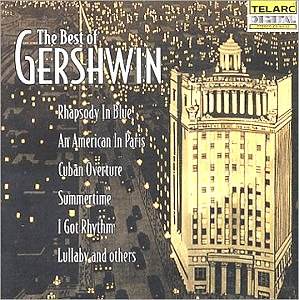![]()
![]()
![]()
![]()
![]()
![]()
![]()
![]()
![]()
![]()
![]()
![]()
![]()
![]()
![]()
![]()
|
|
|
|
|
|
|
|
|
|
|
|
|
|||||||
|
|||||||||
|
|
|
|||||||
| April 2001 Film Music CD Reviews |
Film Music Editor: Ian Lace |
index page/ monthly listings /April01/
George GERSHWN
The Best of Gershwin
Erich Kunzel conducting the Cincinnati Pops Orchestra * William Tritt, piano (except 'Prelude No.2 - John O'Conor) * Harolyn Blackwell, (soprano)
TELARC CD-80542 [72:02] all pieces previously released on Telarc
AmazonUK AmazonUS

This isn't an album of film music, but who needs an excuse to listen to George Gershwin? Gershwin isn't normally thought of as a film composer, though he did provide music for several films (usually adapting his own stage shows), including Delicious (1931), Girl Crazy (1932) and Shall We Dance? (1937). His influence, not just through his song-writing, but by fusing symphonic-orchestral music with jazz, has had an invaluable and continuing influence on both 20th century American music in general and film scoring in particular. Most, if not all of the pieces on this album have featured in at least one film, while the style has permeated the movies for the sound of the city in everything from romantic comedies to urban crime dramas, just as Wagner has influenced the epic and Copland defined the sound of the West. Gershwin's solo piano writing surely prefigured Dave Grusin's The Firm (1993), while since Woody Allen's Manhattan (1979), Rhapsody in Blue (1924) has become almost an unofficial anthem for New York. The truth is, Gershwin's music is gloriously cinematic, evocative and pictorial and makes one wonder what might have happened had he ever scored a dramatic feature, as could have happened had he not died so tragically young.
Seven of the eight tracks here are taken from a series of recordings made by Erich Kunzel with the Cincinnati Pops Orchestra in the early 1980's. In-fact, half the booklet comprises adverts for these albums, making this release something of a sampler (the one track not from this series is the closing Prelude No.2, performed by John O'Conor). A single disc can not really hope to present what the title promises, but it is certainly some of the best of Gershwin, and of course any such a disc is duty bound to offer a version of Rhapsody in Blue. We may have heard in a 1000 times before, but Kunzel makes it fresh, really drawing out the interplay between his orchestra and the dazzling piano of William Tritt. Sometimes music becomes so familiar we fail to really hear it, but this performance is elevated by a concordance which is entirely appropriate of the klezmer music (Gershwin was Jewish and born in Brooklyn) popular in New York in the 1920's - think of Ennio Morricone's score for Once Upon A Time in America (1984). It is an imaginative, well conceived interpretation, which without being radically different makes us remember how vital, new and original this score must have been in 1924, and how brilliant it still is.
Almost inevitably, An American in Paris (1928) follows, with a splendid Cuban Overture (1932) completes the big orchestral showstopping side of the anthology. Anyone who doesn't know these pieces but enjoys flamboyant, optimistic, colourfully scored film soundtracks will delight in discovering them. The slow orchestral blues, Lullaby, dates from 1919, and is attractive without having the quality of the more famous works. However, the exhilarating Variations on "I Got Rhythm" (1934) should put a smile on anyone's face. Gershwin was a brilliant pianist and to hear him improvise on this infectious melody was by repute to witness to a magical musical event. William Tritt gives good account of himself in a classy nine-minute workout. Piano also is at the heart of the Rialto Ripples Rag (1917) and Prelude No.2 - Blue Lullaby (1926), while 'Summertime' from the opera Porgy and Bess (1935) is well delivered by soprano Harolyn Blackwell.
As either an introduction to the music of George Gershwin, or simply a 'Greatest Hits' collection this anthology does the job admirably. There are many Gershwin discs available and this one provides strong performances, a commendable selection of pieces and good value for money. The 1980's sound is excellent.
Gary S. Dalkin

Return to Index
You can purchase CDs, tickets and musician's accessories and Save around 22% with these retailers: |
||||||||
|